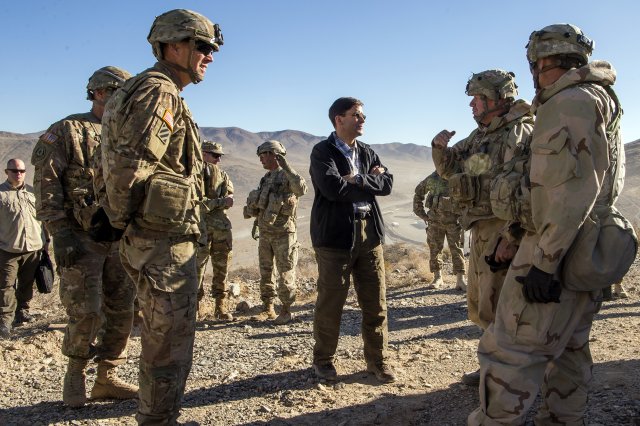Army Secretary: We Will Kill Programs To Fund Big Six
Posted on

Mark Esper reviews troops at his formal welcome as Army Secretary.
WASHINGTON: Dreading the potential return of sequestration cuts in 2020, the Army has started scouring over 800 acquisition programs for things it can cancel to free up funds for its Big Six modernization priorities, Secretary Mark Esper said. The review has already begun “racking and stacking” programs for analysis, Esper said at the Heritage Foundation this morning, but it will be “a long process” to which top leaders can’t give their full attention until the new Army Futures Command stands up this summer.

Ryan McCarthy
Esper’s deputy, Army Undersecretary Ryan McCarthy, told me Tuesday the Army is looking for “efficiencies” in back-office functions like healthcare, IT contracting, and supply chain management that could free up money for the Big Six (artillery, armor, aviation, air & missile defense, networks, and soldiers, in that order). Secretary Esper’s remarks this morning were similar but more forceful, extending beyond services to procurement and eschewing polite language like “efficiencies” in favor of “cutting” and “killing.”
“We have to do our due diligence,” Esper said. “I need to be a good steward of taxpayer dollars to make sure that I can free up all the money I can. And it’s going to mean cutting programs, freeing money from current programs by either slowing them or killing them, whatever the case may be, to free up money for those higher priorities.”
Army leaders are already reviewing the service’s major defense acquisition programs (MDAPs) “on a monthly basis,” Esper said. But the new review will extend far beyond that to examine all 800-plus procurement programs the Army runs. Each will be judged on its individual merits, he said.
Esper is well aware that every program is important to someone, or else it would be a program. But, he said, “we just can’t continue to ramble along funding 800 programs,” trying to spread out the impact of cuts evenly so no one’s pet project takes too big a hit: “The days of spreading peanut butter are over.”

Army Secretary Mark Esper speaks to soldiers at the National Training Center on Fort Irwin, California
Sequestration Strikes Back?
Both Esper and McCarthy made clear that a major motivation for cuts is the Army’s fears for fiscal year 2020, when the current budget deal expires and Budget Control Act caps on spending (aka sequestration) may return.
After big plus-ups in 2018 and 2019, for which the service is grateful to Congress, the natural instinct might be to relax on fiscal discipline, Esper said, but that would be a mistake.
“You fix your roof when it’s sunny out, and right now it appears to be sunny for the next couple of years,” Esper said. “We have to do our best now to find those dollars so we can, again, apply them back to our priorities.”
The new review builds on the earlier Strategic Portfolio Analysis Review (SPAR) process, Esper told reporters after his public remarks. What he didn’t say was the crucial difference: Past SPARs did assess all 800-plus Army programs, but the service has never had such a clear list of priorities it was willing to make sacrifices for.
Will there be decisions on what to cut in time for the 2020 budget now being drafted? It’s too early to say, Esper answered, and a lot has to happen in the next few months.
“I’m pushing on a number of fronts right now,” Esper said. “We do need to do some more things with regard to Army Futures Command, (especially) who will command it, where it will be….But we have begun an effort to start looking at racking and stacking those programs and figure out, once we get them lined up, what do we cut, what do we postpone.”
The service is still figuring out its criteria for choosing what to keep or kill, Esper told reporters. Right now, he said, “I don’t have the answer. I think it’s going to take time. There has to be a process there by which we weigh it out and we look at each one individually.”
“It’s going to be a long process,” Esper said.
Subscribe to our newsletter
Promotions, new products and sales. Directly to your inbox.
